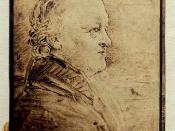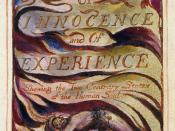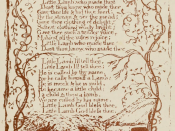Although many poets have outlined childhood and virtue in their poetry, none have done it quite like William Blake. His two collections of poems, "Songs of Innocence" and "Songs of Experience" defined views on purity versus corruptibility during the romantic era. One of his more popular poems, "The Lamb" reflects the ultimate image of wholesomeness and childhood. Likewise, Dylan Thomas, known for his masterful use of language, gives a detailed account of his childhood days at his aunt's farm in his well-known "Fern Hill." The two poems are quite comparable in their imagery and viewpoints.
The more common type of imagery in "The Lamb" and "Fern Hill" is of religious form. Both poets viewed childhood as a time of god-like innocence. During the romantic era, the child became a symbol of so much that was greatly valued in human nature, not only intuition and the imagination but also innocence, untainted by the corruptions of the "experienced".
Blake further established these ideas with "The Lamb". He describes the lamb as symbol of childhood innocence, questioning how it was brought into existence, and suggesting that it was made by a god-like being. Blake constantly questions creation and religion, bringing up the theme of divine intervention and how all creatures were created. The second stanza reveals that the lamb's creator calls himself a lamb, referring to the New Testament, in which Jesus is seen as God's lamb. The traditional image of Jesus as a lamb emphasizes the values of gentleness, meekness, and peace. The image of the child is also associated with Jesus; Jesus displays a special consideration for children, and the Bible's depiction of Jesus in his childhood shows him as honest and vulnerable. This poem acknowledges what Blake saw as the more positive aspects of conservative...



Good
You outline this piece very well. You're viewpoint about both poets is approached very nice.
Well Done!
6 out of 6 people found this comment useful.